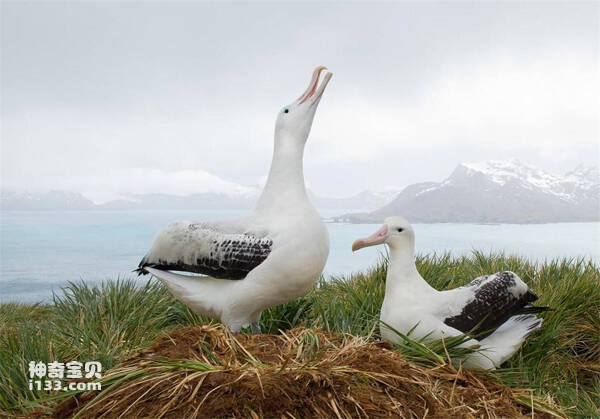Diomedea exulans
IUCN
LCBasic Information
Scientific classification
- name:Diomedea exulans
- Scientific Name:Diomedea exulans
- Outline:Waterfowl
- Family:
Vital signs
- length:About 1.35 meters
- Weight:6-12kg
- lifetime:20-30 years
Feature
It is the largest albatross and has the longest wingspan of any bird
Distribution and Habitat
Wandering albatrosses live near the Southern Ocean and breed on the islands of the back of Antarctica, in particular: South Georgia Island (United Kingdom), Prince Edward and Marion Islands (South Africa), Crozet and Kergren Islands (France) and Macquarie Island (Australia).
Appearance
The wandering albatross has the largest wingspan among existing birds, with an average wingspan of up to 3.1 meters, and the largest confirmed wandering albatross has a wingspan of up to 3.7 meters. The huge wingspan gives the wandering albatross good gliding ability, they can stay in the air for several hours without waving their wings, and at the same time, it can glide 22 meters for every 1 meter height drop. It is about 1.35 m long, and the female is usually slightly smaller than the male, weighing between 6 and 12 kg, and some chicks have been recorded weighing up to 16.1 kg when they first fly. In general, the color of the feathers is related to their age, and the body of the adult wandering albatross is white, and the wings are generally black and white. The female's wings are whiter than the male's, with black tips and trailing edges. They will also have an unnoticeable peach-like spot on the side of their head. Although less obvious, the wandering albatross has the w
Details
Diomedea exulans, the wandering albatross, is the largest species of albatross and has the longest wingspan of any bird, with an average of 3.1 meters and a maximum of 3.7 meters.

Wandering albatrosses are found in the southern Hemisphere. At 40 degrees south latitude, there are 27 days a month when strong westerly winds whip up huge waves, which is an ideal and paradise for albatrosses. It often uses the west wind to make long distance flights from west to east, flying 15,000 kilometers in 10 months. Resting on the sea surface when there is no wind, floating on the sea surface at night. The wandering albatross is a good diver, the best diving albatross, can dive to a depth of 12 meters. It also has a strange stomach, which changes the type of food it eats depending on the weather. The average life span of a wandering albatross is 22.8 years, and nine tenths of its life is spent at sea. Feeding on cuttlefish, small fish and discarded boat waste.
After the age of 4, the wandering albatross can accurately fly to its birthplace and begin to look for a mate, and it is generally necessary to "investigate" for a year or two to identify this "marriage." When wandering albatrosses reach adulthood at 6 or 7 years of age, the females begin to lay eggs. Only one egg is laid at a time, and the eggs are white, spotted and about 10 centimeters long. Incubation takes 78 days, nursing 20 days, and regular feeding. Both sexes share the responsibility of raising the young, a process that ends when the chicks are up to two-thirds larger than their parents.

During the breeding season, they occupy loose territories on islands in the Southern Ocean (such as Auckland, New Zealand, Prince Edward Islands, etc.) to nest and breed. Their nests are volcanic, built of plants and are about a metre wide at the base and half a metre wide at the top.
Wandering albatrosses are tough. In the beginning, life was undisturbed and there were no predators. In the 20th century, it was discovered by sailors in Chinese waters, after which the eggs were stolen and the feathers were robbed, and it encountered the great disaster of the century. It disappeared in the late 1940s and 1950s. Until 1954, more than 200 birds were found on Tokushima Island, Japan. Later, it was endangered by the United States Air Force, and only 40 of the hundred were left, after which they flew back to China. Now there are more than 800.
Listed on the IUCN Red List of Threatened Species (IUCN) 2018 ver 3.1 - Vulnerable (VU).
Protect wild animals and eliminate wild meat.
Maintaining ecological balance is everyone's responsibility!








